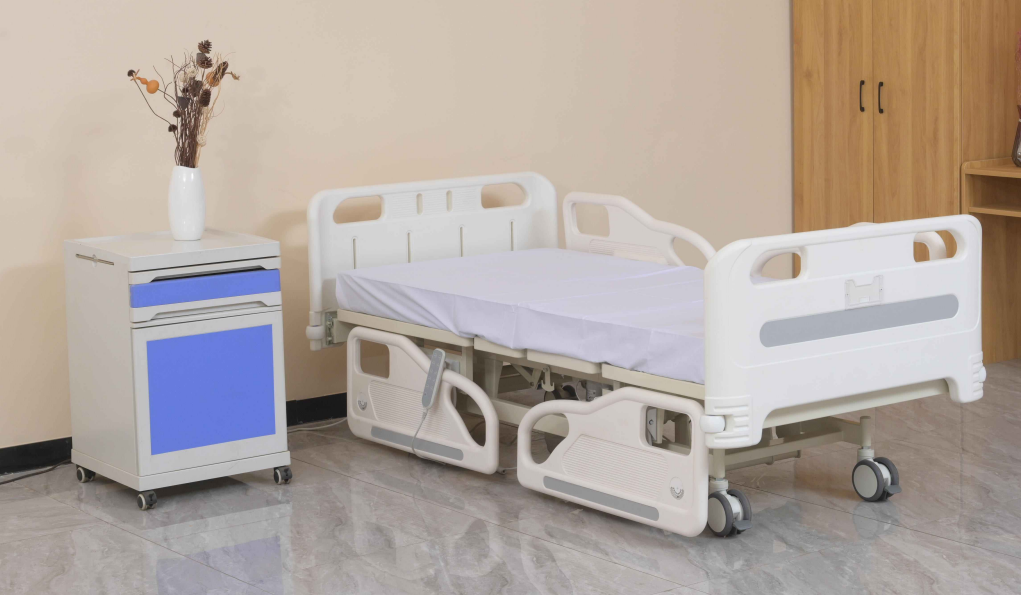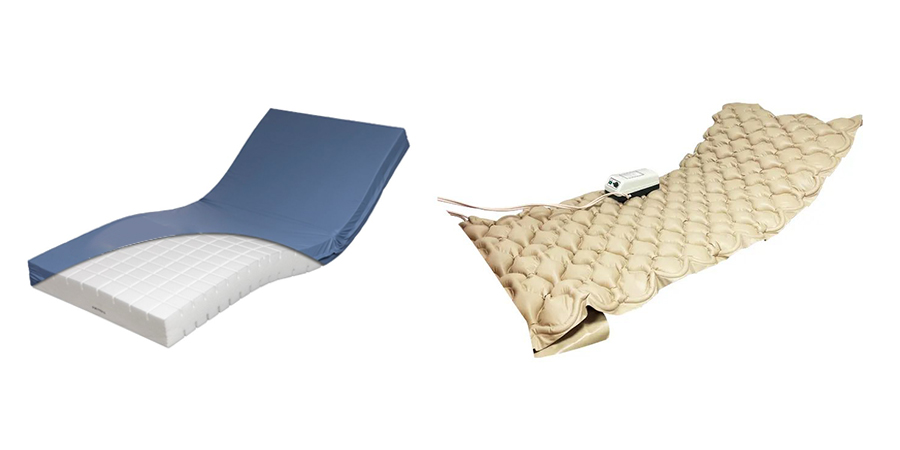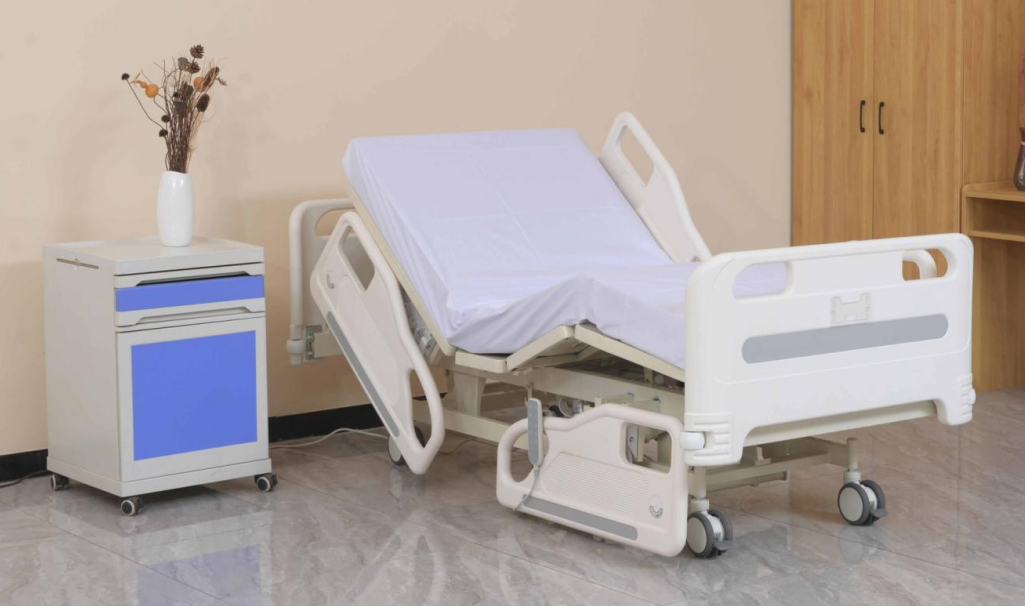Introduction: Why the Quality of Hospital Beds With Mattresses Is Important
I believe a good hospital bed with mattress are vital. They are more than just items; they are key to a patient’s comfort, safety, and recovery. Research proves a clear link between mattress quality and patient results. This includes preventing infections, avoiding injuries, and keeping patients satisfied.

The High Stakes of Hospital Bed With Mattress
In a large study, I found that just 33.5% of mattresses met basic standards. These standards include being waterproof, having good foam, and being free of visible dirt.
Physical damage is widespread. 72% of beds in a major U.S. health system had some type of damage.
I was concerned to see that 95% of mattresses needed to be replaced because of bad stains. More than half had holes or signs of stains inside the cover.
Here’s a critical point: Many of these mattresses were less than four years old. This makes me question our ideas about how long they should last.
Infection Risk & Injury Prevention
From my experience, tears, leaks, and damaged covers reduce comfort. They also create a place for germs to grow. This action increases the risk of infections caught in the hospital. I agree with agencies like the CDC and FDA. They stress the need for regular checks and quick replacements. When you see damage, you must act to stop germs from spreading.
Lifespan and Replacement Planning
The American Hospital Association suggests replacing mattresses every five years. Yet, some makers advise replacement after just 1–3 years.
I recommend a proactive replacement and inspection plan. This process ensures beds stay safe and comfortable for every patient.
The Impact of Smart Mattresses
I find that new advances like smart mattresses are changing patient care. For example, 87.6% of nurses in a survey said smart mattresses are necessary or very helpful. They pointed out that it reduces their physical work. It also improves patient safety and makes their daily tasks more efficient.
So it is crucial to find a high-quality hospital bed with mattress manufacturer.
The Role of a Hospital Bed With Mattress in Patient Comfort and Safety
I believe a good hospital bed with mattress are key for a patient’s comfort and safety. From my experience, this is critical for patients who can’t move much or who might get pressure sores.
How Advanced Mattresses Improve Patient Comfort
I’ve seen more hospitals use high-specification foam mattresses (HSFMs). They have special foam cores and covers that let air flow through. These mattresses keep moisture away and stop the surface from sagging, which makes patients feel much better.
Special surfaces like alternating pressure mattresses (APMs) and HSFMs are now standard. Data from nine UK hospitals shows 48% of patients used HSFMs, while 20% had APMs. This shows how many places are using this pressure-relief technology.
In one project, after a facility upgraded its mattresses, I saw that they had a 50% drop in patient complaints about discomfort.

Key Safety Features of Hospital Beds and Mattresses
Pressure-relieving mattresses and overlays help spread body weight out. This action reduces pressure on certain spots and keeps the skin healthy. It also lowers the risk of pressure sores and related problems, like infections.
Bed entrapment is a serious safety risk. It happens when a mattress is the wrong size or does not fit snugly in the frame. I find this is a common problem with replacement or air pressure mattresses. Patients can slip into gaps by the rails, which can cause injury or death. I always recommend making sure the mattress fits the bed frame perfectly.
Helping Patients Move and Transfer Safely
The hospital bed’s height and its adjustable side rails are very important. I suggest setting the bed to a height that makes it easy for patients to get in and out. If the bed is too high, it becomes a fall hazard, a risk I have seen with shorter or older patients.
Study data confirms that side rails provide stability and mean patients need less help. To avoid injury, you should adjust the rails for each patient’s size and ability to move.
A supportive mattress combined with the right bed adjustments has a huge impact. It helps a patient change positions and transfer without getting hurt.

Improving Patient Health Outcomes
In my experience, specialized surfaces—like reactive air, alternating pressure, or gel mattresses—prevent skin breakdown better than basic foam. I recommend them for use in operating rooms and long-term care.
National UK guidelines suggest these mattresses for any patient at risk of pressure injuries. This confirms their benefits for both safety and comfort.
A Quick Look at the Main Benefits
Keeps skin healthy and helps prevent ulcers
Reduces pain and improves comfort, even for patients who stay a long time
Increases safety when patients are moved or change positions
Lowers the risks that come with not being able to move, such as infections
Lets you provide personal care based on a patient’s size, risk, and mobility level
The following model is a two-function manual hospital bed with mattress produced by Grace Medy. It can meet most of the needs of patients.
Conclusion: Why High-Quality Hospital Beds and Mattresses Matter
From my experience, choosing a quality hospital bed with a supportive mattress is more than a simple convenience. I believe it has a direct impact on a patient’s health and recovery. The proof is clear: when you upgrade to pressure-relieving mattresses and safer beds, you significantly cut the risk of pressure sores. This also increases patient comfort and lowers the chance of falls.
Benefits Backed by Data
I’ve seen clinical results that show advanced mattresses like HSFMs and APMs lead to fewer patient complaints and lower rates of discomfort.
Hospitals that invest in these options see a noticeable drop in pressure injuries and similar problems.
I’ve also found that data from many facilities proves these upgrades help staff work more effectively and meet national patient safety guidelines.
What Makes the Difference
I suggest focusing on safety features. Bed height adjustment and rails help patients get in and out of bed with less risk.
The fit and upkeep of mattresses are very important. I find it concerning that just 33.5% meet basic standards. A staggering 95% need replacement within a few years.
I recommend that you constantly check your mattresses and plan for their replacement. This is essential for safety and hygiene.
Summary
I believe a hospital’s dedication to quality beds and mattresses is about more than meeting standards. It shows you respect your patients’ dignity. It also supports a quicker recovery and helps prevent injuries and infections. I feel that regular investment and staff training on how to use beds and mattresses are vital steps. They help build patient trust and improve health results. Based on my experience, patient comfort and safety start with a great bed and mattress, making them a smart investment for any healthcare setting.
